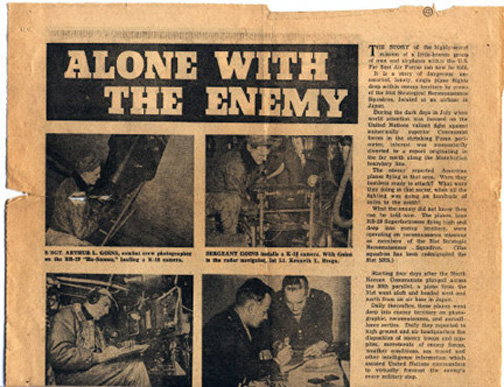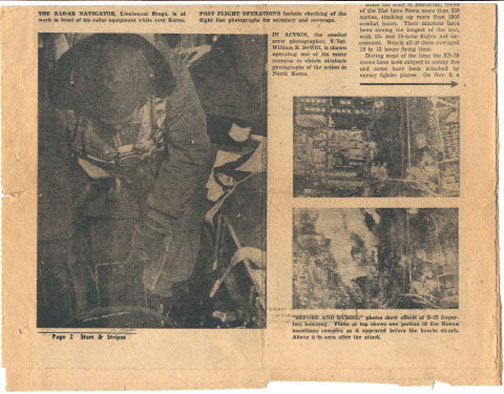Alone With The EnemyCopy of Pacific Stars and Stripes article, December 30, 1950
|
|||||||||
|
Story provided courtesy of William F. (Bill) Welch, crewmember on Lt. Earle Ambrose's crew. |
|||||||||
| The story of the highly secret mission of a little-known group of men and airplanes within the U.S. Far East Air forces can now be told.
It is a story of dangerous unescorted, lonely, single plane flights deep within enemy territory by crews of the 31st Strategic Reconnaissance Squadron, located at an airbase in Japan. During the dark days in July, when world attention was focused on the United Nations valiant fight against numerically superior Communist forces in the shrinking Pusan perimeter, interest was momentarily diverted to a report originating in the far north along the Manchurian boundary line. The enemy reported American planes flying in that area. Were they bombers ready to attack? What were they doing in that sector, when all the fighting was going on hundreds of miles to the south? What the ememy did not know then can be told now. The planes, lone RB-29 Superfortresses flying high and deep into enemy territory, were operating on reconnaissance missions as members of the 31st Strategic Reconnaissance Squadron. (The squadron has been redesignated the 91st SRS) Story continues below illustrations |
|||||||||
|
|
|||||||||
 |
|||||||||
 |
|||||||||
|
|
|||||||||
|
Starting four days after the North Korean Communists plunged across the 38th parallel, a plane from the 31st went aloft and headed west and north from an air base in Japan.
Daily thereafter, these planes went deep into enemy territory on photographic, reconnaissance, and surveillance sorties. Daily they reported to higher ground and air headquarters the disposition of enemy troops and supplies, movements of enemy forces, weather conditions, sea travel and other intelligence information which assisted United Nations commanders to virtually forecast the enemy's every step. Since the start of hostilities, crews of the 31st have flown more than 250 sorties, stacking up more than 2800 combat hours. Their missions have been among the longest of the war, with 15 and 16-hour flights not uncommon. Nearly all of them averaged 10 to 12 hours flying time. During most of the time the RB-29 crews have been subject to enemy fire and some have been attacked by enemy fighter planes. On November 9, a tailgunner, Cpl Harry J. Lavene of St. Louis, Mo. shot down a MIG-15 when a flight of enemy jets attacked his RB-29. He thus became one of the first airman to score on the prized MIGs. He was later decorated with the Distinguished Flying Cross. After the first FEAF Bomber Command attacks on Wonsan, low hanging clouds hindered photographic efforts for several days. Finally a 31st Superfortress flown by Lt. Earle Ambrose of Greenville, S.C., roared down to 1500 feet and skimmed over the city to make pictures, drawing enemy fire from the city and nearby hills. On Aug. 27, Lt. Earl Myers of Grand Island, Neb. and his crew spotted 90 tanks in one area a few miles west of Hamhung. Fighters and light bombers roared in to bring the concentration under attack. Photographs taken the next day revealed a major part of the tank force destroyed. Flash reports from crews of the 31st played an important part in helping stem the flow of troops and supplies from across the border into Korea in September. On Sept. 16, Maj. Robert T. Ray of Little Rock, Ark. and his crew spotted 200 vehicles moving to the battle front. Air support was moved in quickly after the flash report to strafe, bomb, and rocket the vehicles. It was a lone RB-29 from the 31st, flown by Lt Robert T. Ebey of Topeka, Kans. that took the first photographs of Sinuiju, Korean city on the banks of the Yalu River and twin city on the Manchurian border. A flash report from Ebey on Nov. 1 disclosed the presence of more than 50 enemy airplanes on the field there. A few hours later, flight after flight of F-80 and F-51s of the Fifth Air force raked the field with rockets and .50 caliber machine gun bullets and left the enemy air concentration broken and burning. Still another RB-29 from the 31st, piloted by Lt. David L. Muller of New York City, hovered low over the Communist stronghold of Kanggye on Nov. 5, while high above, other B-29s from FEAF Bomber Command rained thousands of fire bombs on the supply center and communications hub. The following day, "before and after" photos of Kanggye were spread over the desks of intelligence and operations officers at FEAF Bomber Command and FEAF for analysis of damage inflicted. The same thing happened early in the war before and after strategic strikes on the Wonsan oil refinery, the Konan munitions and chemical complex, the Seoul bridges, important marshaling yards and more recently in the fire bombing of 18 resupply centers in far North Korea near the international border, and the Shinuiju bridge complex. In all these cases the 31st Strategic Reconnaissance Squadron crews photgraphed the targets prior to missions and after bombs were dropped. The squadron was in the Far East theater - at Okinawa - when the war broke out. It was in action four days later. It has been functioning ever since, under the command of Lt. Col. Edward D. Edwards of Altadena, Calif. and with a cloak of necessary secrecy wrapped around it. Reconnaissance made it possible to destroy military targets with fire bombs, and leave untouched homes and hospitals in the same general area. The industrial area of Konan was obliterated, while workmen's houses nearby were left untouched. Such precision bombing is made possible by accurate reconnaissance furnished by the 31st - until now an anonymous air element engaging in extremely dangerous operations high in the air over enemy territory." Home - Contact Us - Cold War Hist. - 91st SRS Hist. - Stardust 40 Mission Story |
|||||||||